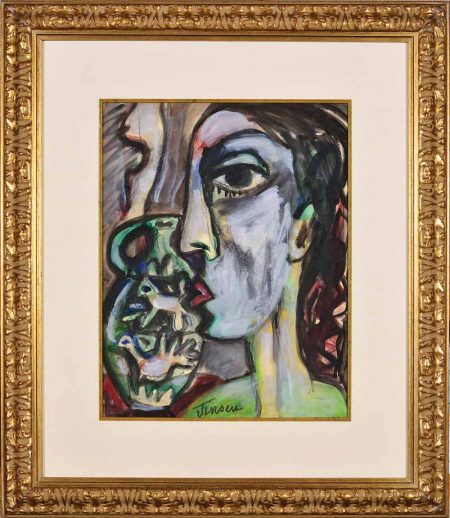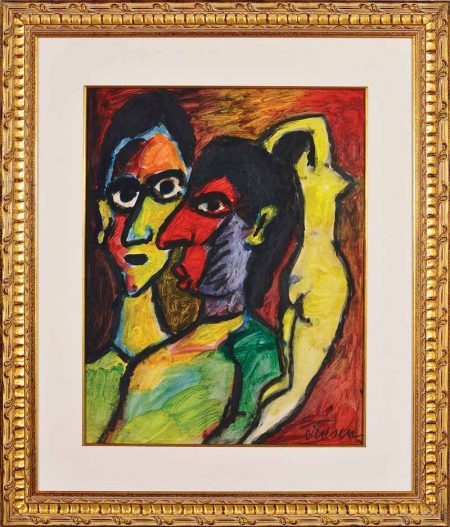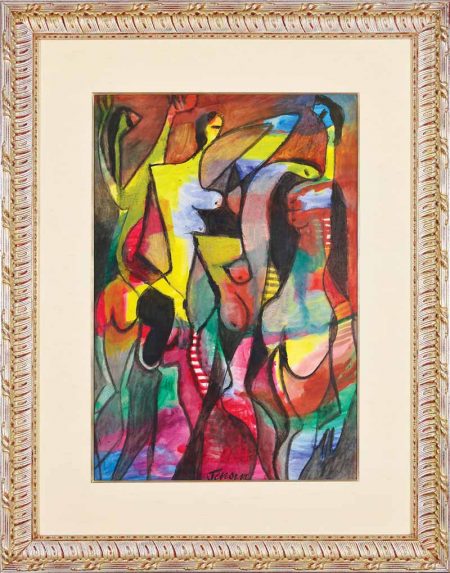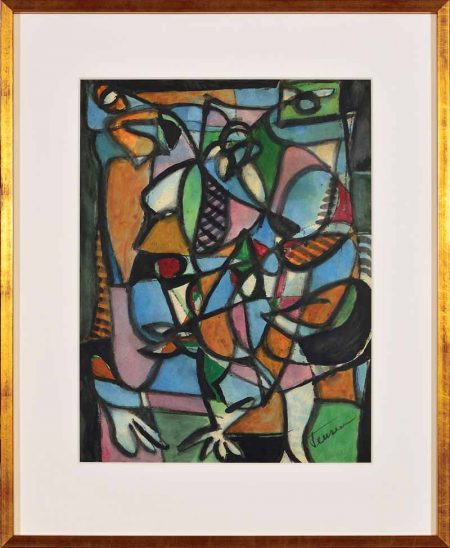
“The Object of Desire”
Oil on Paper
26 x 20 inches
Signed Lower Center
Cincinnati Art Galleries has managed to represent the estate of the late modernist painter Jens Jensen, and an exhibition of this artist’s work is currently on view at Cincinnati Art Galleries downtown. It’s difficult to describe the delight and joy at looking at an excellent modernist in today’s highly politicized and digitalized postmodern world: Jensen’s work is not about race, gender, class, or a critique of consumer capitalism. It’s about how artists who followed modernism’s painterly masters, Picasso, Matisse, and Braque, in particular, reinterpreted reality after the huge breakthroughs in Western culture right before World War I.
Physics taught people that not everything visible to the eye and the senses constituted visual reality: atoms, germs and the like were newly found, and the subconscious and unconscious, along with the Ego and that unbridled Id, were invented, shall we say, by Sigmund Freud around this same time frame. A shattering, fractured and factured world was invented and created both by Picasso and Braque around the same time, and Picasso is clearly Jens Jensen’s main influence on his own paintings. But like other modernists, Jensen built on Picasso’s ideas and visual strengths and minimalist tendencies to create a world very much his own, and that world is admirably and fully shown in the current exhibition, which is accompanied by a lavish, full-color catalogue.

“In the Artist’s Studio”
Oil on Paper
28 x 22 inches
Signed Lower Right
Artists of the modernist era were fascinated by what was then called “primitivism” in non-Western cultures: Picasso notoriously borrowed (today, we’d say “appropriated”) the masks of Iberian and African cultures, in particular, finding in the radical reductivism of these cultures’ work an appealing formalist language new to the West. Surfaces of paintings became foreshortened; perspectives shift in front of our eyes, often offering different perspectives on the same picture plane, concurrently: these are the parts of Picasso’s vocabulary most favored by Jensen himself. The almost all female images in Jensen’s portrait and/or figurative work borrows the angularity of faces so evident in Picasso’s work, but Jensen favored the people of Central and/or Southeastern Europe, Slavic in particular, for his faces: they are generally angular, with large brown/black eyes dominating, and very angular noses, as in “Colorful Portrait”, oil and mixed media on paper. Jensen paints with blocks of color, often primaries, such as red, yellow, and blue, the dominant colors of painting in the early twentieth century. These blocks of color swirl around the head and angular face of the woman depicted: her very long neck and very stylized clothing brings to mind the work of Modigliani, too. The color in the woman’s face also enhances its mask-like appearance,as do the overscaled huge dark eyes. The figure merges in and out of the background, and looks forward to the allover paintings of the Abstract Expressionists. And, like other modernist masters, Jensen paints still lifes, usually with guitars and fruit (see “Guitar and Fruit”, oil and mixed media on paper); Jensen shows his real mastery of composition in paintings like this one; he’s an expert in creating movement through color and masses in his work. One often feels as if the paintings are swirling in front of our eyes, boldly and abstractly. The works of both Kandinsky, the early modern master of lyrical abstraction, has surely been noted by Jensen, and influences from Paul Klee’s organic abstractions manifest themselves in paintings such as “Earth Tones”, oil on paper.

“Green Eye”
Oil on Paper
35 x 23 inches
Signed Lower Right
Jensen’s interest in the totemic, the identity-haunted faces of early modernism, is manifest in works like the three powerful faces in “Three Points of View”, an oil and mixed media work also in this show, and in “Four Faces”, oil and crayon on paper. Jensen combines aspects of Giacometti’s sculptures about the newly alienated Western man with the totemic paintings of Modigliani, but Jensen’s work is very much his own as he tosses his influences boldly around in his paintings. A common and useful compositional element Jensen frequently utilizes is bold black outlines around nearly everything he paints: at times, in paintings like “Breath of Fresh Air”, an abstract composition (oil and mixed media on paper), these outlines not only create spatial dimensions, but they give the total painting the look and feel of stained glass, which offers a reverence not common in modernism. These outlines also convey Jensen’s interest in the work of the French painter Georges Rouault, too: it’s obvious how much Jensen has learned from sheer observation, and that’s truly impressive. These black “lines” of paint also are like a confrontation to Matisse, whose work was generally defined by color, not line; Jensen has managed to make both color and line equally important in his paintings, which are also a kind of conversation to and with other artists of his era. His sense of the truly reductivist face/mask is widely evident in a masterful painting like “Deep Blue Listening” (oil and mixed media on paper). One can see how much Jensen enjoyed the very act of painting, again preceding the same in the work of the American Abstract Expressionists, also known as “action painters” (Harold Rosenberg).

“Four Nudes with Stripes”
Oil on Paper
38 x 26 inches
Signed Lower Center
One of the most fascinating aspects of Jensen’s paintings is his movement in and out of the look of German Expressionism, which painted people in very highly sophisticated urban environments, known for the distortion of the figures, attenuation of line and color, and powerful impact on the viewer (these were the kinds of paintings Hitler found “degenerate”). Jensen’s “Green Eye”, oil on paper, is a masterpiece, showing a woman in an “S” curve on the right side of the painting, and a still life with flowers on the upper left; how Jensen merges the two together is amazing and again shows his brilliance at composing, or designing, his paintings. “The Glance”, oil on paper, is another totemic figure, this time probably male, seen in profile, with one huge eye looking at the viewer; the face feels sculpted , rather than painted; this painting combines many elements from both modernism and German Expressionism, and that’s quite a feat. And paintings like “The Journey”, oil and mixed media on paper, combine elements of figuration and portraiture with abstraction, and we’d see this painting as highly spiritual in today’s overcharged culture. “The Journey” is another of Jensen’s masterpieces.

“Breath of Fresh Air”
Oil and Mixed Media
23 x 17 1/2 inches
Signed Lower Right
It’s highly unusual to be able to call paintings “masterpieces” in today’s world, but this exhibition of work by Cincinnatian Jens Jensen is full of them. The show offers visual pleasure, is a wealth of combined influences from other masters of modernism, and reminds us of the radical power that modern art brought with it. Jensen is a powerful exemplar of modernism, and this exhibition is replete with examples of his numerous styles and experiments. It’s a great exhibition of paintings, and one I hope many younger viewers see, so they, too, can see for themselves how modernism at its finest influenced the entire twentieth century, and continues to do so today without losing any of its immense power and sense of confidence in the act and art of painting itself.
–Daniel Brown